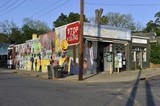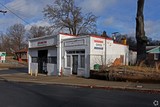Grocery and Convenience Stores
Introduction
Author-Uploaded Audio
Listen to a narration of this entry's description by UNCC Urban Institute User.
Text-to-speech Audio
Images
Store in 2020

Store with mural painted

Prior to mural

Backstory and Context
Text-to-speech Audio
The businesses that remained in the neighborhood after the mill closed changed to accommodate the needs of residents over time. Ultimately, many closed and only a handful of business structures remain. Over time, grocery stores changed to convenience stores, which lacked the full array of food.
In 2020, the Belmont neighborhood was considered a food desert, due to the limited access to affordable and nutritious food. Local convenience stores do not provide fresh produce and full-service grocery stores are greater than a mile away, which presents a challenge for residents who do not have transportation.
Now, let’s head back south on Pegram Street and turn right, or west, on to East 18th Street. You are now in the former community of Eastend and will travel 5 and a half blocks to the Little Sugar Creek greenway. We will talk about some of the City of Charlotte’s investments in Belmont as we go.
From 1970 to 1985, Belmont’s population dropped by nearly a third. Forty percent of the housing units had deteriorated, and many were unoccupied. Charlotte’s City Council adopted a plan to use code enforcement to address abandoned houses, install curbs and gutters to solve drainage problems and make some improvements at intersections. After careful study in the late ‘80s, zoning changes were enacted to reduce density, increase homeownership, and stabilize the neighborhood.
The Belmont Area Revitalization Plan was adopted in 2003 and built on the earlier studies. It resulted in a 20-year phasing plan to prioritize projects that could quickly address perceived and actual blighting conditions, thereby setting the stage for attracting new investment. The vision was for Belmont to be a family-oriented community, diverse in age, culture, and income, that promotes public safety, economic and community development, affordable housing, and community pride — a place to live, work and play. With these improvements, Belmont has indeed become an attractive neighborhood, and today’s home prices reflect that.
Soon you will cross North Alexander Street. Look for the medallion at 624 East 18th Street on your left.
